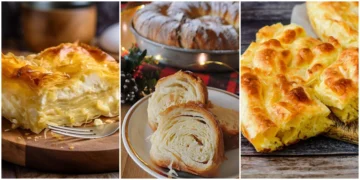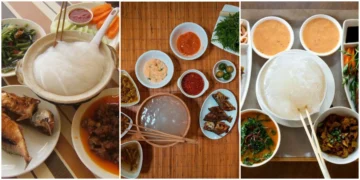Greenland—located in the Arctic region and home to a delicately preserved culture formed over centuries, boasts the striking icy landscapes of the world’s largest island. It also has an interesting history of settlements. Suaasat is the best food of Greenland. It is a soup that has fed generations of Inuit people, is at the core of Greenlandic culinary culture. Traditionally prepared with seal meat, sometimes featuring reindeer, whale, or other locally available meats, Suaasat is not a simple stew. It is a defrosting embrace that brings forth a sense of preservation to the people and their deep-rooted bonds with nature.
Why Suaasat Is the Best Food of Greenland?

In an attempt to survive the harsh Arctic environment we currently live in, food options seem extremely limited. Suaasat has earned its revered status in Greenlandic cuisine for its remarkable ability to transform our undoing into a source of comfort and sustenance. The seasoning is enhanced by the natural fats, subtle hints of spice, and salt, which infuse the broth and meat. While everything is cooked slowly, the meat becomes incredibly tender, while fats deepen the taste of the broth. All of which results in tender meat, healing fats, and rich complex broth, which can cure any brutal Arctic chill.
Moreover, Suaasat is a traditional dish implying deep-rooted customs. It is a reservoir of distinct values such as identity, adaptability, and unfathomable respect for natural resources found in Greenland, cherished by its resilient inhabitants. Furthermore, the cleft of unifying experience empowers social bonds, inducing a communal identity purposefully built on resilience. The embracing blend of iodised sea brininess, earthy flavours, and subtle meat brine, converging upon savoured richness, culminates in something Arctic people deeply cherish; it is not merely food, it is culture.
Key Ingredients of Suaasat
Greenland’s unique environment is reflected in the Suaasat recipe ingredient selection:
- Seal Meat: Its distinctive characteristics come from seal meat, which has gamey and rich flavours. Suaasat is traditionally prepared using seal meat, considered one of the tastiest parts of the seal. The natural fat of the meat renders down while it is slowly cooked, adding a prominent character to the broth and giving it a silky consistency.
- Aromatic Vegetables: Onion and sometimes even garlic are added to the broth to build a smooth and delicious base. They add complex sweetness, which balances the strong taste of the meat.
- Water or Broth: The soup’s liquid base is usually water; however, in some more contemporary versions, a weak broth raised from simmering the meat is used to enhance the flavour.
- Seasonings: For some, the mix of salt and pepper is too much, as excessive flavour will mask the natural characteristics of the ingredients. Freshness is brought to the dish by wild herbs added in some variations.
- Optional Vegetables: Root vegetables such as carrots and potatoes may be added in small quantities. This addition can slightly sweeten the soup while also adding to its thickness. However, traditional recipes often emphasise the unadulterated taste of the meat.
- Fat: The natural fat of the seal is critical. It enriches the broth and provides vital calories needed to withstand the extreme cold.
Art of Preparation of Suaasat (Best Food of Greenland)
- Meat Preparation: The fresh seal meat is cleaned and the fat trimmed (some fat is desired for flavour). It is cut into sizeable chunks that can withstand lengthy cooking and extreme heat. In many households, the meat is enhanced in flavour and seasoned before the cooking process.
- Sautéing Aromatics (Optional): In normal preparations, finely chopped onions are fried in a bit of oil or rendered seal fat until soft and golden. This step, although not mandatory, will enhance the flavour of the broth.
- Simmering: The prepared meat is placed in a large, heavy pot. Water (or sometimes a light broth made from the meat’s juices) is added, covering the meat completely. The pot is brought to a boil, and then the heat is reduced, allowing the meat to simmer slowly for several hours. During the first few hours of cooking, the seal’s natural fat renders into the broth, making the broth as well as the meat tender and succulent. The slow cooking process is essential—it not only tenderises and seasons the meat, but also blends the soup to a rich, satisfying finish.
- Final Adjustments: The Suaasat is almost finished when its broth has been perfected, the mouthfeel has been appropriately salted, and a pinch of salt and a sprinkle of reclaimed herbs added, if need be. These last few adjustments crafted that are bold yet delicate, layered but simple, warming and hearty but still clean within the broth.
- Serving: Once ready, Suaasat is ladled into bowls and served hot. Traditionally, flatbread, or less often, some regional starch, is served alongside so that customers can scoop the tasty broth. A dish’s communal aspect is reinforced with generous portions designed for sharing among family and friends.
What Makes Suaasat Unique?

Suaasat incorporates a unique blend of being created out of necessity, along with its traditional components. In the harsh, freezing cold of Greenland, traditional food safekeeping methods require gentle heat. A perfect example of how local communities adapted to their harsh surroundings is Suaasat. It transforms readily available seal meat into something not only comforting but also nutritious. The fermentation, combined with slow simmering, makes the broth achieve rich flavours and beautiful delicacy.
Furthermore, Suaasat embodies Greenlandic culture. It is a dish that promotes communal soup sharing as a warm social custom. Greenlandic identity revolves around community and sustainable culture, making Suaasat more than a dish, but rather a resilient symbol of togetherness.
History of Suaasat (Best Food of Greenland)
Suaasat traces its roots alongside Greenland’s history and the survival tactics of its indigenous people. The people of Greenland have for centuries depended on hunting and fishing in one of the harshest places on Earth. Seal fat is extremely caloric, making it a key staple. To ensure that the community could preserve food long into winters and enjoy it, traditional methods of slow cooking and food preservation were created out of necessity.
Throughout history, Suaasat has become more than simply a stew; it has developed into a symbol of Greenland’s enduring connection with nature. This dish illustrates a living culinary tradition that embodies the creativity, endurance, and togetherness of the Greenlandic nation. Suaasat is part of the cooking heritage in many households and communities. It symbolizes an age-old way of life that has nourished people for generations.
Other Authentic Delicacies from Greenland
- Mattak: Fresh or dried whale skin and blubber consumed in its traditional forms.
- Suaasat Variations: Some households have their own versions of the dish, using other types of game or fish.
- Kiviak: A traditional winter food which involves the fermentation of small seabirds in seal skin—a less common dish today, but one that illustrates the cleverness of traditional food preservation techniques.
- Local Breads: A type of flatbread is simple to prepare and made from local grains.










Discussion about this post